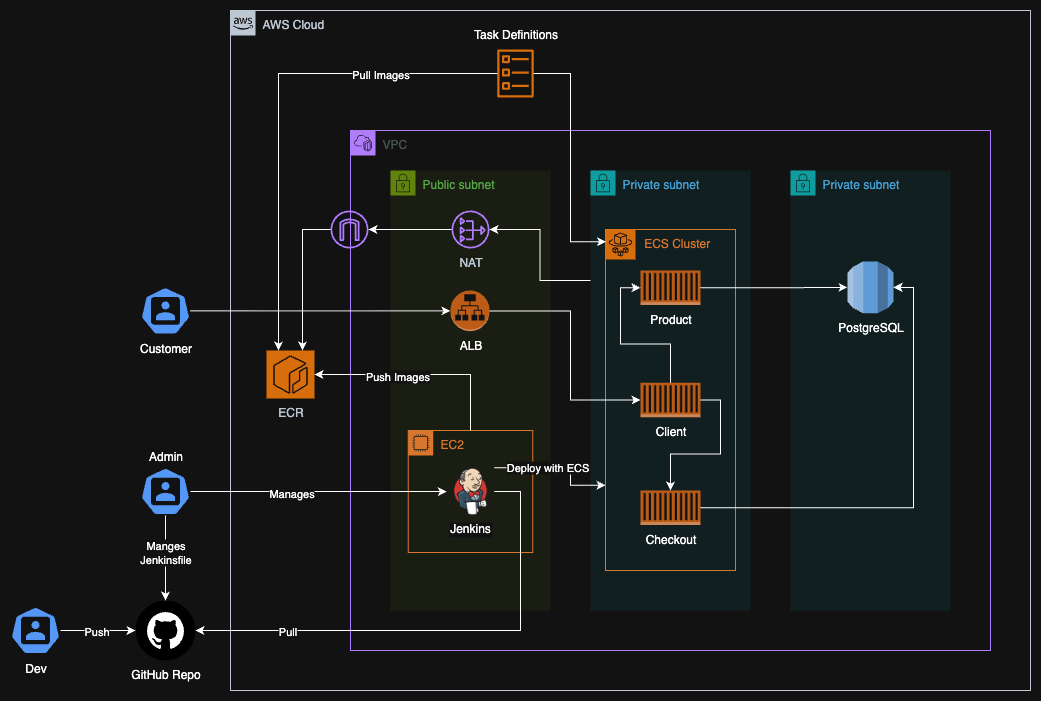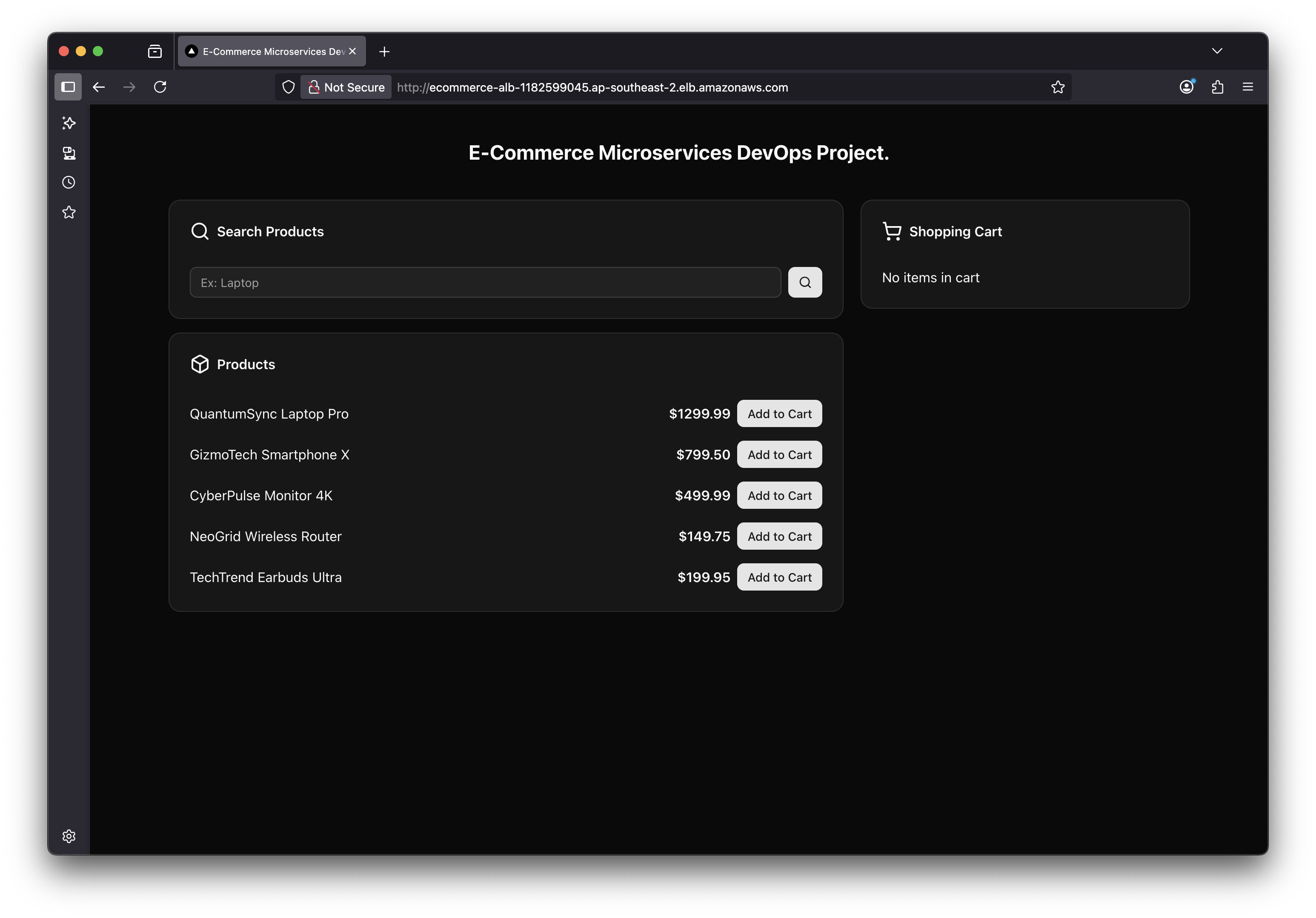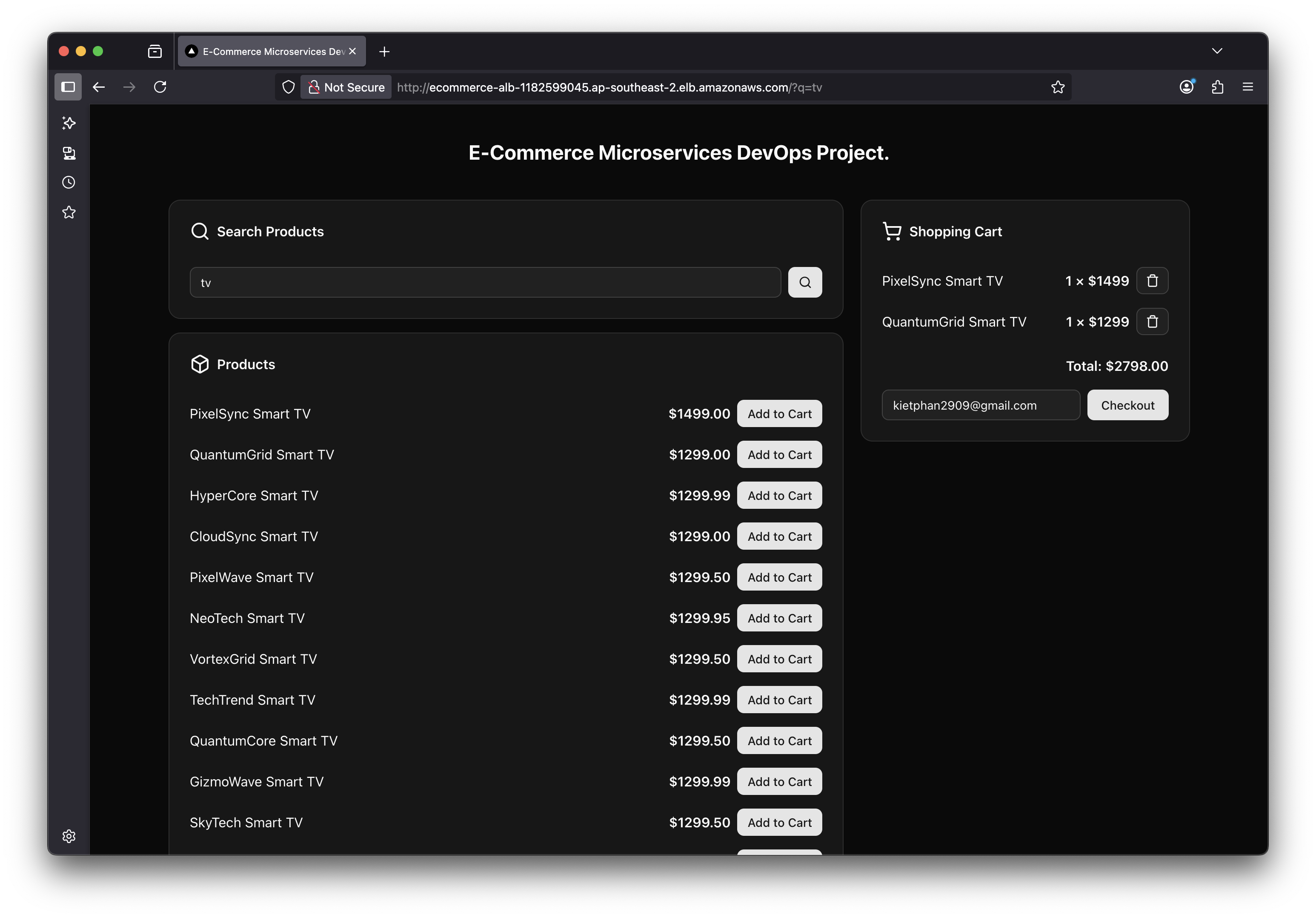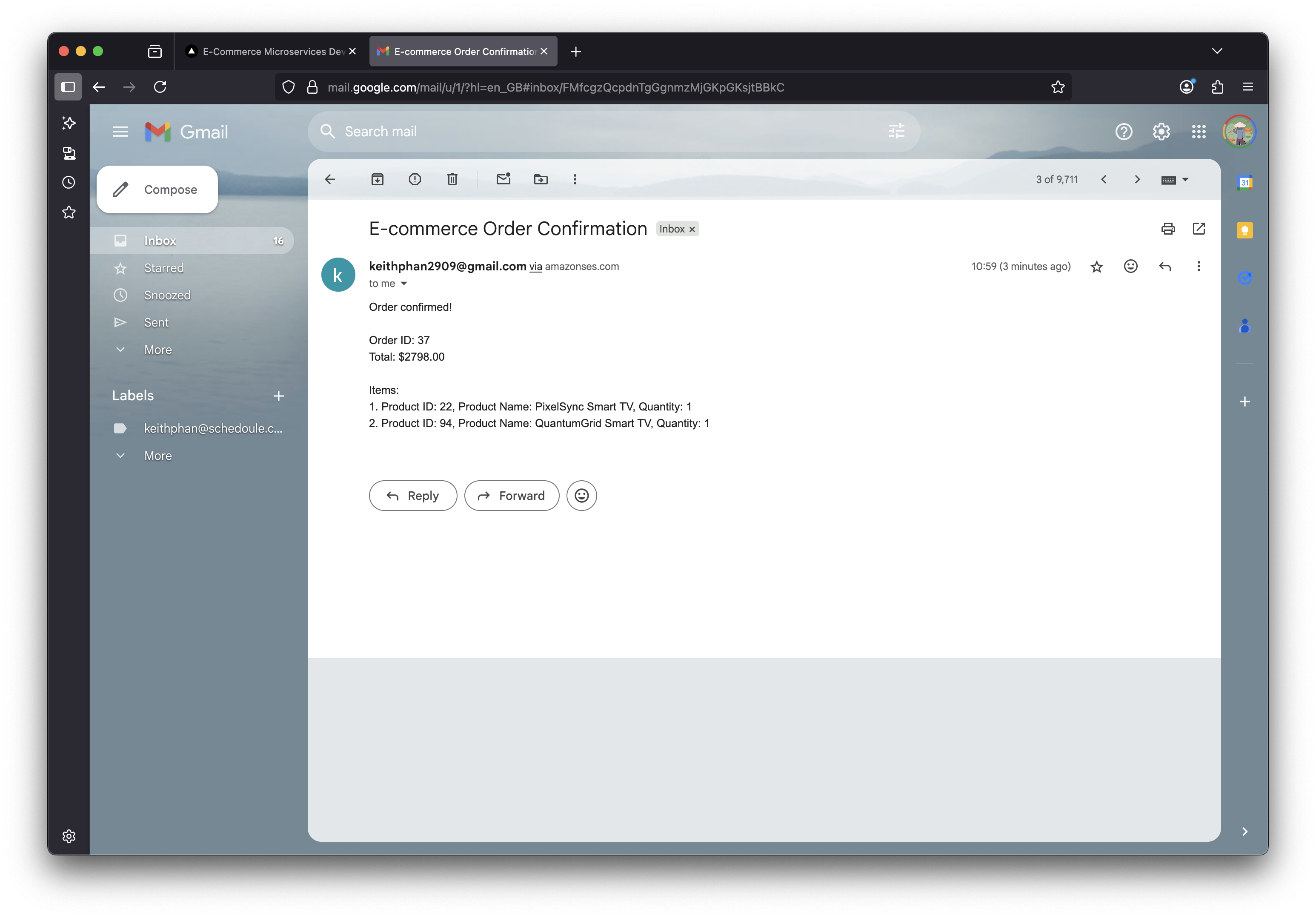CI/CD with AWS
Overview
This project is about building a CI-CD pipeline with Jenkins to AWS ECS (Elastic Container Service) for a simple microservices e-commerce application.
🔥 The tech
- E-commerce application:
- Front-end service: NextJS
- Back-end services: NodeJS
Database: PostgreSQL (AWS RDS)
- DevOps Tools:
- GitHub
- Jenkins
- Docker
- Aws Services:
- ECR: Stores docker images
- ECS: Orchestrates all containers
- RDS: Hosts PostgreSQL database server
- SES: Sends simple email notifications
💻 Application structure
- client/ : NextJS application
- Dockerfile: Building instructions for Docker
- product-service/ : Express application for product APIs
- Dockerfile: Building instructions for Docker
- checkout-service/ : Express application for sending email notification
- Dockerfile: Building instructions for Docker
- Jenkinsfile: CI-CD pipeline
👀 Review application code
Client (port 3000)
app/api/checkout/
export async function POST(request: Request) { const { email, items, total } = await request.json(); try { await fetch(`${process.env.CHECKOUT_SERVICE_URL}/checkout`, { headers: { "Content-Type": "application/json", }, method: "POST", body: JSON.stringify({ email, items, total }), }); return NextResponse.json( { message: "Checkout successful" }, { status: 200 } ); } catch (error) { console.log(error); return NextResponse.json({ error: "Failed to checkout" }, { status: 500 }); } }app/api/products?q=seach-keyword
export async function GET(request: NextRequest) { const { searchParams } = new URL(request.url); const search = searchParams.get("search") || ""; try { const response = await fetch( `${process.env.PRODUCT_SERVICE_URL}/products?search=${search}` ); if (!response.ok) { throw new Error(`Backend responded with status: ${response.status}`); } const data = await response.json(); return NextResponse.json(data); } catch (error) { console.error("Error fetching products:", error); return NextResponse.json( { error: "Failed to fetch products" }, { status: 500 } ); } }
Product Service (Port 3001)
/products?seach=search-keyword
app.get("/products", async (req, res) => {
const search = req.query.search || "";
let query = `SELECT * FROM products WHERE name ILIKE $1`;
if (!search) {
query += ` LIMIT 5;`;
}
const { rows } = await pgPool.query(query, [`%${search}%`]);
res.json(rows);
});
Checkout Service (Port 3002)
/checkout (Sends email with SES - AWS SDK)
app.post("/checkout", async (req, res) => {
const { email, items, total } = req.body;
// Logic: Clear cart, create order
const result = await pgPool.query(
"INSERT INTO orders (email, total) VALUES ($1, $2) RETURNING id",
[email, total]
);
const orderId = result.rows[0].id;
for (const item of items) {
await pgPool.query(
"INSERT INTO order_items (order_id, product_id, quantity) VALUES ($1, $2, $3)",
[orderId, item.id, item.quantity]
);
}
// Send email
const orderDetails = items
.map(
(item, idx) =>
`${idx + 1}. Product ID: ${item.id}, Product Name: ${
item.name
}, Quantity: ${item.quantity}`
)
.join("\n");
const emailBody = `Order confirmed!\n\nOrder ID: ${orderId}\nTotal: $${total}\n\nItems:\n${orderDetails}`;
const params = {
Destination: { ToAddresses: [email] },
Message: {
Body: { Text: { Data: emailBody } },
Subject: { Data: "E-commerce Order Confirmation" },
},
Source: process.env.SES_SOURCE,
};
await ses.sendEmail(params).promise();
res.send("Checkout complete");
});
☁️ AWS Infrastructure Setup

VPC

- Name: ecommerce-vpc
- 2 AZ: ap-south-east-2a, ap-southeast-2b
- 2 public subnets:
- 10.0.1.0/24
- 10.0.2.0/24
- 4 private subnets:
- 10.0.10.0/24
- 10.0.11.0/24
- 10.0.20.0/24
- 10.0.21.0/24
- NAT Gateway
Load Balancer & Target Groups
- Target Groups
- Port: 3000 (Client Service)
- Private subnets:
- 10.0.10.0/24
- 10.0.11.0/24
- Application Load Balancer
- Name: ecommerce-alb
- Listening port: 80
- Public subnets:
- 10.0.1.0/24
- 10.0.2.0/24
- Security group:
- Name: ecommerce-alb-sg
- HTTP: 80 - 0.0.0.0/0 (From anywhere)
EC2 Setup (Single Jenkins)
- OS: Ubuntu 24.04
- Instance type: m3.large
- Storage: 20GB
- VPC: ecommerce-vpc
- Subnet: 10.0.1.0/24
- Security Group:
- Port 8080: Jenkins default UI application
- Port 50000: Optional for communication to Jenkins agents
- Port 22: SSH
- IAM Role:
- AmazonEC2ContainerRegistryPowerUser (for ECR)
- AmazonECS_FullAccess (for ECS)
- User data script (initialise instance with Jenkins and Docker):
#!/bin/bash
sudo apt update -y && sudo apt upgrade -y
# Install Java
sudo apt-get install fontconfig openjdk-17-jre -y
# Download Jenkins
sudo wget -O /usr/share/keyrings/jenkins-keyring.asc \
https://pkg.jenkins.io/debian-stable/jenkins.io-2023.key
echo "deb [signed-by=/usr/share/keyrings/jenkins-keyring.asc]" \
https://pkg.jenkins.io/debian-stable binary/ | sudo tee \
/etc/apt/sources.list.d/jenkins.list > /dev/null
sudo apt-get update -y
# Install Jenkins
sudo apt-get install jenkins -y
sudo systemctl enable jenkins
sudo systemctl start jenkins
# Download & Install Docker (Optinal if need Docker as a builder)
sudo install -m 0755 -d /etc/apt/keyrings
sudo curl -fsSL https://download.docker.com/linux/ubuntu/gpg -o /etc/apt/keyrings/docker.asc
sudo chmod a+r /etc/apt/keyrings/docker.asc
echo \
"deb [arch=$(dpkg --print-architecture) signed-by=/etc/apt/keyrings/docker.asc] https://download.docker.com/linux/ubuntu \
$(. /etc/os-release && echo "${UBUNTU_CODENAME:-$VERSION_CODENAME}") stable" | \
sudo tee /etc/apt/sources.list.d/docker.list > /dev/null
sudo apt-get update -y
sudo apt-get install -y docker-ce docker-ce-cli containerd.io docker-buildx-plugin docker-compose-plugin
sudo systemctl enable docker
sudo systemctl start docker
# Add the Jenkins User to the Docker Group
# sudo chmod 666 /var/run/docker.sock (Less Recommended)
sudo usermod -aG docker jenkins
sudo systemctl restart docker
sudo systemctl restart jenkins
# Installing AWS CLI
curl "https://awscli.amazonaws.com/awscli-exe-linux-x86_64.zip" -o "awscliv2.zip"
sudo apt install unzip -y
unzip awscliv2.zip
sudo ./aws/installServices Security Group
- Name: ecommerce-services-sg
- Ports:
- 3000 - From ecommerce-alb-sg
- 3001 & 3002 - From itself (ecommerce-services-sg)
RDS PostgreSQL Setup
- Engine: PostgreSQL
- Private subnet group:
- 10.0.20.0/24 - ap-south-east-2a
- 10.0.21.0/24 - ap-southeast-2b
- Parameter groups:
- rds.force_ssl: 0 (For demonstrating purpose)
- Security group:
PostgreSQL: 5432 - From ecommerce-services-sg
ECR Setup (Elastic Container Registry)
3 repositories for 3 microservices:
- ecommerce-cicd-project/product-serivce
- ecommerce-cicd-project/checkout-serivce
- ecommerce-cicd-project/client
ECS Setup (Elastic Container Service)
Task definitions:
ecommerce-client
- Launch type: AWS Fargate
- Container: ecommerce-cicd-project/client:latest
- Port: 3000
- Environment variables:
- PRODUCT_SERVICE_URL: http://product-service:3001
- CHECKOUT_SERVICE_URL: http://checkout-service:3002
ecommerce-product-service
- Launch type: AWS Fargate
- Container: ecommerce-cicd-project/product-serivce:latest
- Port: 3001
- Environment variables:
- PG_URL: postgresql://postgres:(RDS DB password)@(RDS DB hostname):5432/ecommerce
- ecommerce-checkout-service
- Launch type: AWS Fargate
- Container: ecommerce-cicd-project/checkout-serivce:latest
- Port: 3002
- IAM Role:
- AmazonSESFullAccess
- Environment variables:
- PG_URL: postgresql://postgres:(RDS DB password)@(RDS DB hostname):5432/ecommerce
- SES_SOURCE: keithphan2909@gmail.com (Source Email)
Cluster:
- Infrastructure: Fargate
- Namespace setup for service-to-service communications
- Services:
- ecommerce-client-service:
- Launch type: Fargate
- Task definition: ecommerce-client
- VPC: ecommerce-vpc
- Security group: ecommerce-services-sg
- Private subnets:
- 10.0.10.0/24
- 10.0.11.0/24
- Namespace: Cluster’s namespace
- Loadbalancer: Application Balancer (above)
Target group (above)
- ecommerce-product-service:
- Launch type: Fargate
- Task definition: ecommerce-product-service
- VPC: ecommerce-vpc
- Security group: ecommerce-services-sg
- Private subnets:
- 10.0.10.0/24
- 10.0.11.0/24
- Namespace: Cluster’s namespace
- DNS: product-service
- Port: 3001
- ecommerce-checkout-service:
- Launch type: Fargate
- Task definition: ecommerce-checkout-service
- VPC: ecommerce-vpc
- Security group: ecommerce-services-sg
- Private subnets:
- 10.0.10.0/24
- 10.0.11.0/24
- Namespace: Cluster’s namespace
- DNS: checkout-service
- Port: 3002
- ecommerce-client-service:
Jenkinsfile breakdown
Environment Variables:
environment {
AWS_REGION = "ap-southeast-2"
AWS_ACCOUNT_ID = "412381745022"
AWS_ECR_REGISTRY = "${AWS_ACCOUNT_ID}.dkr.ecr.${AWS_REGION}.amazonaws.com"
CLIENT_REPO_NAME = "ecommerce-cicd-project/client"
CLIENT_REPO_URL = "${AWS_ECR_REGISTRY}/${CLIENT_REPO_NAME}"
PRODUCT_SERVICE_REPO_NAME = "ecommerce-cicd-project/product-service"
PRODUCT_SERVICE_REPO_URL = "${AWS_ECR_REGISTRY}/${PRODUCT_SERVICE_REPO_NAME}"
CHECKOUT_SERVICE_REPO_NAME = "ecommerce-cicd-project/checkout-service"
CHECKOUT_SERVICE_REPO_URL = "${AWS_ECR_REGISTRY}/${CHECKOUT_SERVICE_REPO_NAME}"
CLUSTER_NAME = "ecommerce-cicd-project"
CLIENT_SERVICE = "ecommerce-client-service"
PRODUCT_SERVICE = "ecommerce-product-service"
CHECKOUT_SERVICE = "ecommerce-checkout-service"
}
Stage 1: Docker Login
stage ("Docker Login") {
steps {
sh "aws ecr get-login-password --region ${AWS_REGION} | docker login --username AWS --password-stdin ${AWS_ECR_REGISTRY}"
}
}
Stage 2: Build Docker Images & Push To ECR
Use changeset to detect file based changes (Only build images on services that changed)
stage ("Build Docker Images & Push To ECR") {
parallel {
stage ("Client") {
when {
changeset "client/**"
}
steps {
echo "************************ Client ************************"
sh "docker build -t ${CLIENT_REPO_URL}:latest ./client"
sh "docker push ${CLIENT_REPO_URL}:latest"
}
}
stage ("Product Service") {
when {
changeset "product-service/**"
}
steps {
echo "************************ Product Service ************************"
sh "docker build -t ${PRODUCT_SERVICE_REPO_URL}:latest ./product-service"
sh "docker push ${PRODUCT_SERVICE_REPO_URL}:latest"
}
}
stage ("Checkout Service") {
when {
changeset "checkout-service/**"
}
steps {
echo "************************ Checkout Service ************************"
sh "docker build -t ${CHECKOUT_SERVICE_REPO_URL}:latest ./checkout-service"
sh "docker push ${CHECKOUT_SERVICE_REPO_URL}:latest"
}
}
}
}
Stage 3: Deploy
Use AWS CLI to force new deployment and changeset to detect services changed
stage ("Deploy") {
parallel {
stage ("Client") {
when {
changeset "client/**"
}
steps {
echo "************************ Client ************************"
sh "aws ecs update-service --cluster ${CLUSTER_NAME} --service ${CLIENT_SERVICE} --force-new-deployment"
}
}
stage ("Product Service") {
when {
changeset "product-service/**"
}
steps {
echo "************************ Product Service ************************"
sh "aws ecs update-service --cluster ${CLUSTER_NAME} --service ${PRODUCT_SERVICE} --force-new-deployment"
}
}
stage ("Checkout Service") {
when {
changeset "checkout-service/**"
}
steps {
echo "************************ Checkout Service ************************"
sh "aws ecs update-service --cluster ${CLUSTER_NAME} --service ${CHECKOUT_SERVICE} --force-new-deployment"
}
}
}
}
Post Stage: Docker Logout
post {
always {
sh "docker logout ${AWS_ECR_REGISTRY}"
}
}
🚀 Final Application
Application is available at application load balancer DNS

Search for products by keywords

Get email confirmation after checking out

Thank You For Reading!